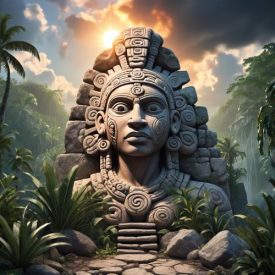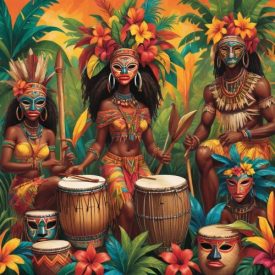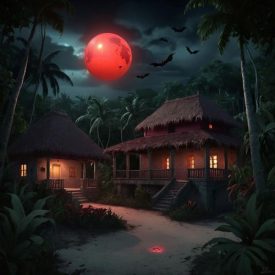Caribbean Mythology
Caribbean mythology is a vibrant tapestry of beliefs, legends, and spiritual traditions woven together from the diverse cultures that shaped the region’s identity. Emerging from the meeting of Indigenous Caribbean, African, and European influences, these mythologies reflect the islands’ unique blend of spirituality, resistance, and storytelling. The earliest layer of Caribbean mythology can be traced to the Taino people, the original inhabitants of islands such as Puerto Rico, Hispaniola, and Cuba. They revered deities known as zemis—spiritual beings connected to natural forces like rain, fertility, and the sea. Figures such as Atabey, the goddess of fresh water and fertility, and Yúcahu, the god of agriculture, formed the foundation of Taino cosmology. Their myths explained natural phenomena, guided agricultural cycles, and offered a deep connection between humanity and nature—values that continue to resonate in Caribbean spirituality today.
As the Caribbean evolved under colonial rule, new mythological and spiritual systems emerged from the fusion of African, European, and Indigenous traditions. Creole mythology became a cultural bridge, preserving ancestral memory through oral storytelling, music, and folklore. It gave rise to trickster spirits, shape-shifting beings, and cautionary tales that blended moral lessons with everyday life. African slaves brought with them rich pantheons of gods and ancestral spirits that intertwined with Catholic saints, resulting in syncretic religions like Vodou and Santería. In Haitian Vodou, for example, the lwa—spiritual intermediaries between humans and the divine—govern love, health, and justice, with figures such as Papa Legba, Baron Samedi, and Ezili embodying different aspects of existence. Similarly, Santería in Cuba honors the orishas, divine beings from Yoruba cosmology, each linked to elements of nature and human virtues, such as Oshun, the goddess of love and rivers, and Shango, the god of thunder and strength.
Beyond these established belief systems, Caribbean mythology is rich with creatures and spirits that haunt the islands’ collective imagination. One of the most feared and fascinating figures is the Soucouyant, a shape-shifting vampire-like being found in the folklore of Trinidad and other islands. By day, she appears as an old woman, but by night she sheds her skin, transforming into a ball of fire that slips through cracks and keyholes to drink the blood of her victims. This chilling myth served not only as a tale of fear but also as a warning about secrecy, envy, and moral decay within close-knit communities. The story of the Soucouyant reflects the Caribbean’s ability to blend supernatural terror with social commentary, turning myth into a mirror of cultural identity and morality.
Among the lesser-known yet deeply significant traditions is Kalinago mythology, which originates from the Indigenous Caribs who once dominated the Lesser Antilles. The Kalinago believed in powerful nature spirits and ancestral protectors who governed the forces of the ocean, sky, and forest. They practiced rituals to honor these entities and sought balance between the human and spiritual worlds. Like the Taino, their mythology was rooted in respect for nature and the belief that the world was alive with spirit. Today, Caribbean mythology remains a living tradition, influencing music, art, literature, and religion across the islands. It continues to shape how Caribbean people understand identity, resilience, and the unseen world. Deeply syncretic, ever-evolving, and profoundly spiritual, Caribbean mythology stands as a testament to the region’s history, creativity, and enduring belief in the power of the sacred.







